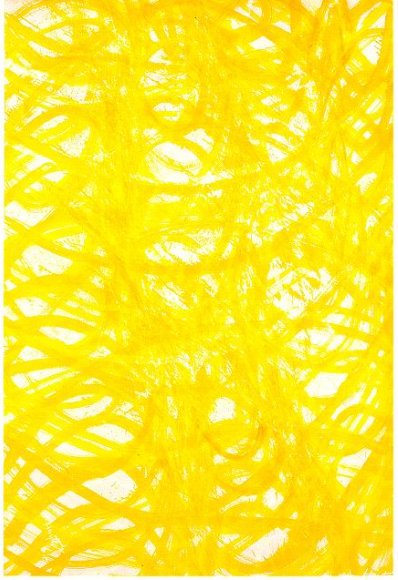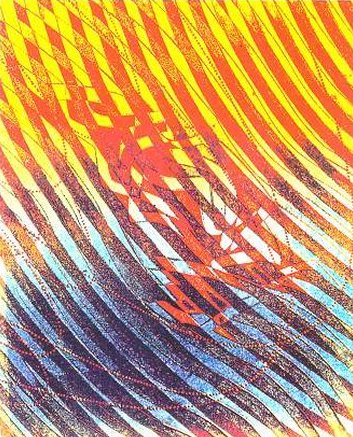
AFTER-IMAGE (VIBRATIONS)
The operation continues with the
investigation of actual after-images showing how saturating the field of a painting with
one colour can create unexpected results which transform one's idea of the power of a
single colour.
'For these experiments wax crayons, felt pens in different colours, inks, gouache even
fluorescent acrylic colours like Dayglo, Flashe, Light etc will be needed. Covering the
complete sheet a total composition is attempted with a single colour leaving intervals of
the white or coloured sheet.---/"
In this experiment the saturation with yellow is employed in doing an unconscious drawing.
After a short time of staring into this yellowness, during the time it takes for the eye
to become fatigued and to utilize its compensating mechanism, a bright reddish-purple
emerges floating so solidly that one is hard pressed to realize that it is not a pigment
but an after-image. Sometimes one must look aside and look at the drawing to check that
the pigment is not really there. Of course the purplish-violet colour is visually there
but by way of another mechanism.

.XXXII. YELLOW SEA, S.W. Hayter, 1964
Painting, 195x130cm, catalogue of the
exhibition "S.W. HAYTER DYNAMISME CHROMATIQUE, 1964-1974", Gallery J.C.
Riedel, 12 rue Guénégaud Paris, Juin 1990.
This seems at first a yellow painting but after staring at it for some time, the time it
takes for the fatigue of the eye to make a respite for itself in creating a violent
flickering purplish-violet in the intervals, purplish colour is seen fiercely there and
one must look aside to be sure it is not there as pigment. Of course, this is more obvious
with a large canvas in which the spectator is enveloped.
'---/ Further experiments involve covering the sheet completely leaving neither white nor black so that the sole resource of expression is the relative opacity of pigment. It has been found that such experiments impart an order of knowledge of a specific pigment which cannot easily be described or transmitted but which becomes extremely valuable in expression.---/'
Fig.191. Composition in yellow covering the
sheet studying the relative opacity of colour.
This composition executed by means of successive layers of unconscious drawings overlaid
until the whole sheet is filled and beyond that so that there are layers of thickness of
pigment, creates an oversaturated field of yellow (the relative difference in the opacity
within the yellow lend differentiation to the individual brush strokes). The
oversaturation produces a strongly violet after-image which obscures the picture in
luminosity and creates framing and moving around the painting and on the many coloured
surroundings also. The intense transitory violet or purple image is a glittering
experience which can scarely be seen in this small format and which could only emerge
fully if it were a huge enveloping structure.
The exposition is continued from single
colour to many colours: how two bands of colour rectangularly placed, interact with each
other through interferences and mutual after-image.
'Transparency and interference of colours are studied by the use of uniform parallel linear systems of each particular colour executed with great precision with a 1:1 or no wider than a 1:2 interval. Here not only the interference of colours is seen in the structure, but as the saturation is determined precisely by the intervals, more definite information is obtained by superimposition than in the operation of passing transparent glazes of colour or using the printing rollers coated with transparent pigments. The appearance of complementary colours in the interval are studied and found to vary considerably from those normally experienced with spots of uniform colour.'
Fig.192. Superposition of pink horizontals
on blue verticals.
Observe these colours and their interferences and simultaneously the interferences of
their two after-images systems - a very kinetic interaction seeming, as they alternately
cancel each other, to flick off and on sometimes one system of parallels appearing,
sometimes the other. While being composed of the most stable elements - the horizontal and
vertical - the whole seems to vibrate.

.XXXIII. CHUTE (FALL) S.W. Hayter,
Etching 599 x 490, 1975, 'The Renaissance of Gravure, the Art of S.W. Hayter',
P.M.S. Hacker, Clarendon Press Oxford, I988.
Investigate two diagonal sigmoid systems in two colours, interfering.
Fig.193. Two diagonal sigmoid systems
in two colours interfering.
These are more mobile in form, the diagonal system having an intrinsic motion,
interposed and interfering with their two sets of after-images, throbbing. All
of these complex interactions - between colours, their opposite after-images
and with the resultants advancing and retreating - remains a labile structure.
back |